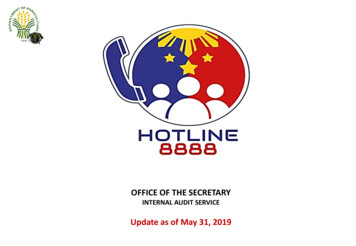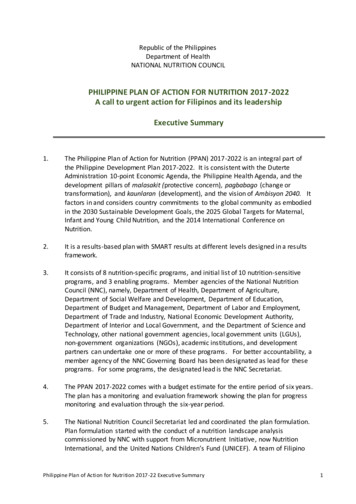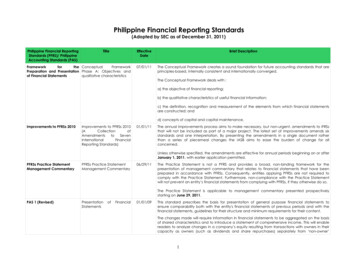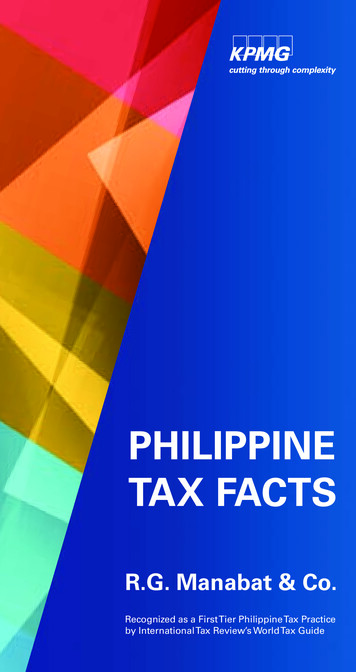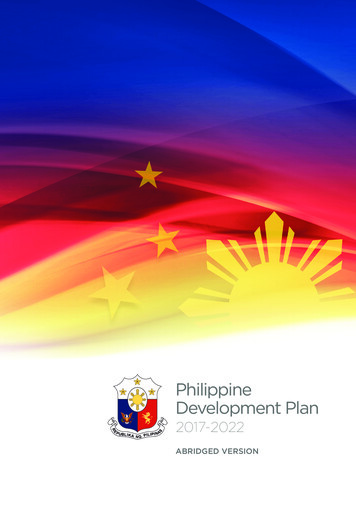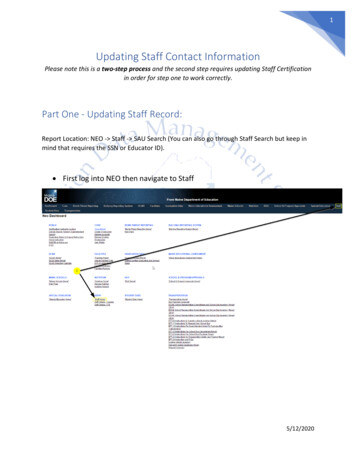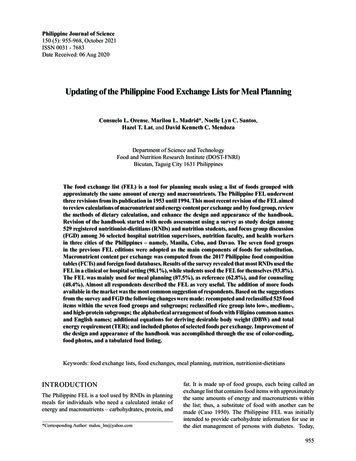
Transcription
Philippine Journal of Science150 (5): 955-968, October 2021ISSN 0031 - 7683Date Received: 06 Aug 2020Updating of the Philippine Food Exchange Lists for Meal PlanningConsuelo L. Orense, Marilou L. Madrid*, Noelle Lyn C. Santos,Hazel T. Lat, and David Kenneth C. MendozaDepartment of Science and TechnologyFood and Nutrition Research Institute (DOST-FNRI)Bicutan, Taguig City 1631 PhilippinesThe food exchange list (FEL) is a tool for planning meals using a list of foods grouped withapproximately the same amount of energy and macronutrients. The Philippine FEL underwentthree revisions from its publication in 1953 until 1994. This most recent revision of the FEL aimedto review calculations of macronutrient and energy content per exchange and by food group, reviewthe methods of dietary calculation, and enhance the design and appearance of the handbook.Revision of the handbook started with needs assessment using a survey as study design among529 registered nutritionist-dietitians (RNDs) and nutrition students, and focus group discussion(FGD) among 36 selected hospital nutrition supervisors, nutrition faculty, and health workersin three cities of the Philippines – namely, Manila, Cebu, and Davao. The seven food groupsin the previous FEL editions were adopted as the main components of foods for substitution.Macronutrient content per exchange was computed from the 2017 Philippine food compositiontables (FCTs) and foreign food databases. Results of the survey revealed that most RNDs used theFEL in a clinical or hospital setting (98.1%), while students used the FEL for themselves (93.8%).The FEL was mainly used for meal planning (87.5%), as reference (62.8%), and for counseling(48.4%). Almost all respondents described the FEL as very useful. The addition of more foodsavailable in the market was the most common suggestion of respondents. Based on the suggestionsfrom the survey and FGD the following changes were made: recomputed and reclassified 525 fooditems within the seven food groups and subgroups; reclassified rice group into low-, medium-,and high-protein subgroups; the alphabetical arrangement of foods with Filipino common namesand English names; additional equations for deriving desirable body weight (DBW) and totalenergy requirement (TER); and included photos of selected foods per exchange. Improvement ofthe design and appearance of the handbook was accomplished through the use of color-coding,food photos, and a tabulated food listing.Keywords: food exchange lists, food exchanges, meal planning, nutrition, nutritionist-dietitiansINTRODUCTIONThe Philippine FEL is a tool used by RNDs in planningmeals for individuals who need a calculated intake ofenergy and macronutrients – carbohydrates, protein, and*Corresponding Author: malou lm@yahoo.comfat. It is made up of food groups, each being called anexchange list that contains food items with approximatelythe same amounts of energy and macronutrients withinthe list; thus, a substitute of food with another can bemade (Caso 1950). The Philippine FEL was initiallyintended to provide carbohydrate information for use inthe diet management of persons with diabetes. Today,955
Orense et al.: Updating of the Philippine FoodExchange Lists for Meal PlanningPhilippine Journal of ScienceVol. 150 No. 5, October 2021the Philippine FEL is used as a guide in prescribing andplanning meals for healthy and therapeutic diets, as well asan educational tool by nutrition professionals in clinics andhospitals, fitness centers, and other health care facilities(Tanchoco et al. 1994).The first FEL was developed in the 1950s by the AmericanDiabetes Association, the American Dietetic Association(ADA), and the United States (US) Public Health Servicefor the management of patients with diabetes (Wheeleret al. 1996). It has undergone several revisions from itsprevious title “Exchange Lists for Diabetes” to “ChooseYour Foods: Exchange Lists for Diabetes” in the sixthrevision published in 2008 (Wheeler et al. 2008; Geil2008). The Philippine FEL was adapted from the USin 1953 by Corpus et al. and was revised in 1965 byMadlangsakay that included six food groups [as citedin Flores et al. (1984)]. The 1965 revision was updatedby Flores et al. in 1984 wherein the sugars and sweetsfrom the rice group were removed to form the sugarexchange as the seventh group. The third revision in 1994by Tanchoco et al. had the subgroups of the vegetableand milk exchanges modified while retaining the sevenmain groups. Some changes in this version included thefollowing: adjustment of portion sizes, use of Filipinolanguage in the food listing, a separate grouping ofprocessed/selected foods, and identified fruits with highvitamin A and vitamin C content. Prior to this study,the 1994 FEL was not updated because the local foodcomposition database was being modified.Tools in nutrition have to be periodically reviewed to keepup with current trends in the management of nutritionrelated conditions. As a guide in dietary planning, the FELshould maintain a list of foods currently available in themarket and which are consumed by many people. Novelfoods that are now part of family meals have to be evaluatedon how these can fit into the diet plan of individuals withdifferent health concerns. Moreover, the popularity of theFEL as a reference material deems it necessary to alwaysprovide timely and adequate information to its users whoare working in the different fields of nutrition.The need to innovate the FEL is important becauseof the rising number of Filipino clients with lifestylerelated diseases who will avail of nutrition education andcounseling. In improving tools for clients, simplicity, easeof use, user-friendliness, and visual appearance are somefeatures that have to be considered in addition to its mainor technical content.The FEL was updated for the purpose of reviewing thecalculations and grouping of foods based on current toolsand nutritional recommendations, improving the methodsof assessing individuals using updated methods, andenhancing the design and appearance of the handbook.956METHODST he st udy protocol was approved and projectimplementation was cleared on 28 March 2017 bythe Department of Science and Technology–Foodand Nutrition Research Institute’s (DOST-FNRI)Institutional Ethics and Review Committee (ProtocolCode FIERC-2017-006). Signed informed consentforms were obtained from the study participants priorto data collection. Participants were informed of theconfidentiality of all the information obtained fromthem and that their participation in the study is voluntaryand they can withdraw from the study anytime withoutpenalty. Data collection was conducted from April 2017–March 2018. The authors declared no conflict of intereston this project.The steps undertaken in coming up with the 2019 FELwere: 1) collection of data on the needs of FEL users bymeans of survey and FGDs, 2) review and computationsof the macronutrient content of exchange portions of eachfood item, and 3) revision/updating of content and designof handbook.SurveyThe survey among FEL users was done using a pretested, semi-structured self-administered questionnaire.Survey questions evaluated the technical content, thephysical attributes – comprehensibility, usefulness, layout,and design – that were used to improve the 1994 FELhandbook.The target population was users of FEL in the Philippines.The RNDs were initially targeted as respondents, but theaddition of student respondents was later on consideredas users of FEL in school. The inclusion criteria for FELusers were any of the following: 1) RND staff in hospitalsand wellness centers, 2) teachers of major nutrition coursesusing FEL, or 3) students of nutrition in their senior years.Excluded from the study were non-users of FEL or personsnot belonging to the mentioned criteria. The number ofrespondents was calculated based on a 50% proportion ofFEL users, with 95% confidence and a 1.0 design effect.Using the Open Epi software version 3.01, the numberof respondents needed to satisfy the sampling conditionswas approximately 400 individuals (Dean et al. 2013).A listing of RNDs from government and private hospitalsof the National Capital Region (NCR) and other areas wassecured from heads of dietary, food service, and nutritionclinics via phone inquiry or internet search. Letters weresent to these institutions to request their participation.The survey questionnaires and consent forms for theRNDs were sent either by courier, personal delivery andpick-up, or email.
Philippine Journal of ScienceVol. 150 No. 5, October 2021For respondents in the academe, a listing of schoolsoffering nutrition programs was obtained from theProfessional Regulation Commission. Schools withhigh enrollment in nutrition programs were selected torepresent the students who use the FEL. Coordinationwith the school and the faculty handling major nutritionsubjects was made through letters of request or email,which were sent to school heads or the faculty concerned.The distribution and retrieval of the forms from theschool to the researchers were also done by the facultycontact person. Consent forms were also attached to thequestionnaire to seek approval to participate in the study.FGD and Expert Group ConsultationConsultation meetings through FGDs were conductedin Manila, Cebu, and Davao in order to represent theRNDs from the three main islands (Luzon, Visayas,and Mindanao) of the country. RNDs involved inclinical nutrition, with supervisory positions, and amongeducators/teachers/professors using the FEL in teachingwere recruited for the FGD. For each area, participantswere identified through inquiries from correspondinginstitutions to represent the clinical, school, or foodservice so that varied responses can be gathered from eachsector. One FGD group was composed of 12 participants.A member of the research team facilitated the discussionusing guide questions that were similar in content with thesurvey from FEL users. Specifically, the FGD solicitedsuggestions on the existing food groupings or lists, itemsto add and/or delete in the 1994 handbook, and items toinclude for this revision.The researchers audio-recorded the comments andsuggestions of the participants together with hand-writtennotes taken simultaneously during the FGD session. Datawere organized according to similar topics or themes.Aside from the survey and FGD, an expert group in thefield of clinical nutrition consisting of five RNDs and amedical doctor was consulted on the technical contentsand various aspects of the development and revisionprocess of FEL. The group also had varied expertise inresearch, policymaking, and foodservice.Macronutrient Computation and Grouping of FoodsThe seven food groups in the 1994 edition (DOSTFNRI 1994) were used as the starting point to classifythe exchanges – vegetable, fruit, milk, rice, meat, sugar,and fat – as recommended by the expert group and FGDparticipants. Additional food items were included in eachgroup based on the suggestions from the survey, FGD, andexpert group. Data on the most common foods consumed byFilipinos from the 2013 National Nutrition Survey (DOSTFNRI 2015) also served as an additional data source.Orense et al.: Updating of the Philippine FoodExchange Lists for Meal PlanningA working database file was kept for each food groupthat contains information on the food item description,nutrient contents, and a food code that matched an itemin the 2017 Philippine FCTs.The macronutrient and energy contents of foods werecalculated from the new FCTs (DOST-FNRI 2017a)and other food databases such as those from Australia,ASEAN, Japan, Korea, and the US. Using MicrosoftExcel software, the edible portion (EP) weight of thefood was determined to provide one exchange portion.Small adjustments were made on the weight of thefood per exchange to avoid difficulty in translating it tohousehold measure, e.g. fractions of a spoon or teaspoon.The cut-off values for macronutrients per exchange thatserved as a guide for the food groupings were based onprevious editions of FEL but were also agreed upon withthe expert group.Mean, standard deviation (SD), and 95% confidenceinterval (CI) of the macronutrients were computed foreach food group and subgroup. Foods that did not meet thevalue or range of macronutrients per group were classifiedunder “selected foods,” where the number of exchangesof a food group was indicated instead, such as rice, meat,fat, or sugar exchange.Actual food samples were purchased from differentsupermarkets, public markets, and other sources. For eachfood item, weighing was done using an electronic digitalscale (Shimadzu UX2200 H), values were recorded tothe nearest whole number in gram (g), while a standardruler with millimeter and centimeter (cm) units was usedto measure the food item’s dimension in cm. Thereafter,foods were described in household measures (e.g. cup,tablespoon, or teaspoon) or in terms of its dimension(length, width, and height or diameter in cm) when thereis no fixed portion size. Photos of one exchange of foodsamples were compiled for documentation.Revision, Updating, and Design of the 4th EditionFEL HandbookThe revised or 2019 FEL was formatted with three parts –introduction, food exchange groups, and appendices. Theintroduction provided basic information on the use of thefood exchange groups, i.e. the steps in dietary calculationand the menu plan. The seven major food lists and groups– vegetable, fruit, milk, rice, meat, fat, and sugar – withdetailed description and measurement in exchange unitpresented in Part 2. The Appendices section contained allother food lists and nutrition assessment tables relevantto meal planning and diet instruction. The final versionof the handbook, including the layout, was based onsuggestions from the survey, FGD, and the expert group.Another activity in the completion or finalization stage957
Philippine Journal of ScienceVol. 150 No. 5, October 2021was the final review done by the DOST-FNRI technicalstaff and external peer reviewers.Data Processing and AnalysisData on the survey part used descriptive statisticsto generate frequency distributions on the profile ofrespondents and evaluation on selected physical attributesof the 1994 FEL handbook – comprehensibility, clarity,and usefulness. For the FGD, transcribed data wereorganized and similar topics or themes were analyzedand combined for tabulation. The recurring themes werecategorized as follows: food subgroups, weights andmeasures, foods to delete, foods to add, and foods toregroup – including the other relevant remarks presentedby the group. All responses obtained from the survey andFGDs were discussed with the technical experts for finalresolution.For the calculation of food exchanges, the computedenergy, carbohydrate, protein, and fat values werepresented as mean, SD, and 95% CI. All descriptivestatistical analyses were performed using SPSS (version20, IBM, Armonk, NY, USA).RESULTSProfile of RespondentsOf the total 529 survey respondents composed of RNDsand students, 54.5% were from NCR and the rest werefrom other parts of the country. The RNDs comprisedabout 60% of the total respondents while almost 40%were nutrition students in their senior year in college andhad used the FEL. The majority of the respondents werefemales while only about one in 10 respondents weremales. In terms of educational attainment of RNDs, about14% attained a postgraduate degree. Most of the RNDrespondents (83.2%) were affiliated with hospitals andmore than half were working for five years or less. Bylocation of work, the majority were from NCR (78.2%),while the rest were from Regions 4A, 11, 7, 2, 1, andCordillera Administrative Region (CAR). The studentrespondents were highest in the Region 4A area (Table 1).The FGD participants (n 36) were mostly affiliatedwith hospitals (63.9%) and the academe (30.5%).Two participants were medical doctors with nutritionbackgrounds and experience in clinical nutrition (no tablepresented).Survey on the 1994 FEL HandbookAs shown in Table 2, from the point of view of RNDs, theFEL was intended for use by hospitals or clinical RNDs958Orense et al.: Updating of the Philippine FoodExchange Lists for Meal Planning(98.1%), instructors/professors of nutrition (86.8%), andstudents (89.7%). The majority of student-respondents(93.8%) agreed that the FEL was intended for them,followed by the hospital and clinical RNDs (85.2%),faculty (74.2%), and health workers (61.4%). As to itsusefulness, the majority (65.7%) of all respondents said itwas very useful, while a third of the respondents (33.7%)found the FEL to be a useful tool.Respondents were asked how they used the FEL in theirjobs. According to RNDs, the FEL is used mainly for mealplanning (85.6%) and nutrition counseling (82.4%). Forstudent-respondents, the majority (90.5%) also used theFEL for meal planning, then as personal reference in morethan half of this group.In terms of its physical attributes, the majority of the RNDsand students agreed that the title “Food Exchange Listsfor Meal Planning” was very clear (51.4%), while 47.4%of said the title was clear/fairly clear and very few (1.2%)found the title not clear. Almost the same proportionof RNDs (87.0%) and students (85.9%) mentioned noconfusing words encountered. However, few respondents(13.0% and 14.1%) of RNDs and students, respectively,found some items that confused them.The comments on the physical attributes of the FEL werecovered to improve the visual appearance of the handbook(Table 2). These were expressed in terms of the layoutdesign, use of language, use of pictures or illustrations,and additionally, the features that the respondent foundto be attractive. Results showed that while the layoutdesign and language were rated as appropriate by agreater proportion of all respondents (90.0 and 80.9%,respectively), a few found the layout too informal (5.5%)and language (11.0%) too difficult. Also, more than half(54.5%) claimed that the illustrations/pictures were notattractive. A few respondents of the RNDs and studentsidentified the features that attracted them and these includethe cover design (17.9%), font size (13.4%), illustrations(8.9%), and layout (15.3%).The suggested changes in the content of the food listingwere combined for RNDs and students (Appendix TableI). Merging of data was done to have a common basis forthe changes to be incorporated in the update of the FEL.The addition of more foods was suggested by a largeproportion of respondents (40%) for vegetable, fruit,milk, rice, and meat. About three out of 10 respondentssuggested including both the “as purchased” (AP) andEP weight of foods especially for vegetables and fruits,while a smaller proportion was recorded for the rest of thefood groups. Deletion of food items was suggested by asmall proportion of about 3%. The reason for wanting todelete was the unavailability of foods in the market andthat the food was no longer consumed in the area. For
Orense et al.: Updating of the Philippine FoodExchange Lists for Meal PlanningPhilippine Journal of ScienceVol. 150 No. 5, October 2021Table 1. Profile of survey respondents (n 529).VariableRNDsNutrition studentsAll tional attainmentUndergraduate0021010021039.7College graduate27385.60027351.6Master’s .0AffiliationHospitalAcademeFood service/industryNutrition/fitness centerTotalNumber of years as RND 2 yr2–5 yr6–10 yr11–15 yr16– 20 yr 20 yrTotalRegionNCRRegion 4ARegion 11Region 7Region 12Region 10Region 5Other regions (CAR and Region 1)Totalvegetable and fruit, diameter measurement was favored fordeletion by 27.1 and 14.1% of respondents, respectively,while a lower proportion was observed for the rest of thefood groups. An issue for the change in the carbohydratecontent of the rice exchange was posed as a question andabout 8% were in favor of the move.The survey respondents also suggested foods to addor delete and improve in the forthcoming handbook(Appendix Table II). For the vegetable exchange, theinclusion of more commonly eaten food available inthe market, and the addition of different varieties ofvegetables like mushroom or cabbage were suggested.The name of group A or B vegetables as a subgroupwas found confusing to some respondents. In the fruitexchange, imported fruits and some local/indigenous fruits– including their varieties like banana and melon – weresuggested for addition while those not commonly eatenlike anonas, datiles, mabolo, and tamarind can be deleted.For easy recognition for fruits, pictures or illustrations help959
Orense et al.: Updating of the Philippine FoodExchange Lists for Meal PlanningPhilippine Journal of ScienceVol. 150 No. 5, October 2021Table 2. Survey on the attributes of the 1994 FEL Handbook among FEL users.VariablesRNDs (n 319)nNutrition students (n 210)%All respondents (n 529)n%n%Users of 9.719793.848391.3Health workers18558.012961.431459.45918.552.46412.2Very 3.710.321.030.629459.619940.4493100Meal planning27385.619090.546387.5Nutrition 117933.8Personal reference21266.512057.133262.8216.673.3285.3Very 24647.4Not rsbUsefulness of the FELNot usefulTotalresponsecUses of theFELaOthersdClarity of the titleTotalresponsecWith confusing words/phrasesYesNoneTotalresponsecLay-out designToo .0Too .9418.1Appropriate23978.117285.141180.9Too 42.061.2Attractive11738.610652.522341.1Not geSimpleTotalresponsecIllustrations/picturesVery attractive960
Orense et al.: Updating of the Philippine FoodExchange Lists for Meal PlanningPhilippine Journal of ScienceVol. 150 No. 5, October 2021VariablesTotalresponsecRNDs (n 319)nNutrition students (n 210)%n%All respondents (n 529)n%3036020240505100Cover design5717.96028.611722.1Font out4313.53818.18115.3aMultiple responses, % computed from total number of RNDs, students, and total respondentsbSpecific response of “others” (medical doctors, fitness workers, meal planners, food industry,cPercent (%) computed from total response as denominatordOthers (e.g. calorie counting and menu evaluation)nursing students, sports, patients, municipal nutrition action officer)to recognize less-common foods. In the milk group, alltypes and variants of milk and products were suggested,including rare and imported ones. Adjustment of themeasures per exchange was also suggested for powderedmilk and other milk alternatives, non-dairy milk, flavoredmilk drinks, and commercially prepared milk for use incertain disease conditions.expression of respondents and the truth in their words.The comments and suggestions from the FGD weresimilar to what was obtained from the survey, and theseare summarized as follows:For the other food groups, respondents suggested morefood items in the rice exchange such as native delicaciesand varieties of noodles and pasta. There was also asuggestion to make a separate list for starchy and nonstarchy foods and that the collective term or name of thegroup as “rice exchange” may not be appropriate becauseother non-rice items were also included.2. For all food groups, add more food items and theirvariants. Include local and international and new foodsthat are available in the market and are commonlyconsumed.For the meat group, various meat sources (lamb, turkey,rabbit), new types of processed food, fast foods, and plantor soybean-based proteins/products were recommended.Respondents also suggested the use of realistic and practicalways to estimate portion sizes such as the use of palm ora deck of cards as examples. Foods with possible healthrisks should also be properly described, such as chickenwith or without skin, and the cholesterol content of thesefoods need to be stated. For the fat exchange, new productswere again identified to be included in the list, particularlythose with health implications, while obsolete brands wereto be deleted. In the sugar exchange, more foods that arecommercially available in different flavors were suggested,including international brands of sugar/sweet products/items. A review of serving portions was also mentionedbecause of changes in the sizes of new products.Information from the FGDComments and suggestions from the FGD group servedto validate the data from the survey. The advantageof this data collection method was the face-to-facecommunication that allowed researchers to see the1. Retain the current reference values of macronutrientsand energy per exchange for the seven food groups.3. Reclassify the vegetable subgroups and the milk group,but the meat and fat subgroups were to be retained.4. Retain measurements in household measures and EPweight in g for all food groups.5. All the participants agreed to remove the number ofcalories in the “vegetable A” subgroup. A suggestionwas made to validate the macronutrient values andreclassify some items in the vegetable exchange likemung bean and lima beans, young corn, and tomatoeswhich were said to be confusing.6. For items under fruits, include local and Englishnames. Check saba banana if this can be consideredunder the rice exchange instead. Also, banana cue,maruya, and turon may contain more carbohydratesand calories due to the added ingredient in cookingsuch as sugar and oil; hence, these can be transferredto other groups as well.7. Update the classification of milk, but retain the skimmilk classification. Add more milk products such assoy milk, goat’s milk, different types of yogurt, wheypowder, and milk substitutes.8. For the rice exchange, the majority suggested theretention of the original macronutrient content of 23 g961
Orense et al.: Updating of the Philippine FoodExchange Lists for Meal PlanningPhilippine Journal of ScienceVol. 150 No. 5, October 2021carbohydrate per exchange, while the ADA exchangeof 15 g was also suggested by other participants. It wassuggested to include different rice varieties, importedgrains, pasta, and noodles.9. In the meat group, include exotic meat, meat from otheranimal parts, street foods, and buffet foods. Includefootnotes for foods that are rich in omega-3, omega-6,monounsaturated fat, and the type of fat in the meat.10. Reclassify margarine and mayonnaise to trans-fat, aswell as canola oil and peanut butter to monounsaturatedfat. Include other types of salad dressing, coconut oilin powder form, virgin coconut oil, shark oil, andall-purpose cream. Include footnotes for foods rich inomega-3 fatty acids.11. Include sugar substitutes with disclaimer under thesugar exchange group. Add new types of sweetenerssuch as coco sugar, caramel syrup, muscovado, stevia,powdered sugar, and dark chocolate.The 4th Edition FELs for Meal Planning:Composition and Summary of Major ChangesThe updated FEL handbook was completed with threemain components – the introductory part, food exchangegroups, and the appendices. The main part highlights thefood exchange groupings and the list of foods containingthe Filipino or common and English names, EP weight,and household measure with selected pictures of foodsper exchange (Figure 1). The FEL generated 525 itemswithin the seven exchange groups. Additional tables inthe appendices were on selected foods (164 food items),beverages (52 food items), alcoholic beverages (27 fooditems), and free foods (44 food items). The Appendicesalso contained references on fatty acid content of fats andoils, methods of pediatric computations, a quick referencefor dietary prescription, and a new table on desirableweight according to normal levels of BMI.The changes made in the 4th edition FEL are summarizedas follows:12. For the diet computations, the inclusion of body massindex (BMI) as a reference was suggested by theFGD and expert group. However, diverse methodsin determining the DBW and TER were reported byparticipants. A consensus at that time was for the RNDsto be able to choose the method that one is comfortablewith to compute DBW and TER in the calculation ofthe energy and macronutrient contents of foods whenplanning daily meals.1. Computation of the macronutrient values using thenewly-updated Philippine FCTs (DOST-FNRI 2017b).Use of other food composition databases such asthose from the US, Australia, Korea, and Japan wereemployed in the absence of macronutrient values inthe Philippine FCTs. Carbohydrate value representsavailable carbohydrates.13. Consider a more appealing layout in landscape styleand edit the spacing alignment. Use 12-font size forthe text. Some groups favor retaining the old size ofthe handbook, but others want a bigger size with anew cover photo. Vegetable exchange only included 3 g ofcarbohydrate and 1 g of protein.14. Consider a short version of the FEL for use by otherallied health professionals like doctors.Computation of Macronutrient and Energy Valuesper ExchangeTable 3 shows that the mean macronutrient values perexchange were within the reference values or 95% CI ofthe means. The mean carbohydrate in the rice and sugargroups were about 1–2 g f
Keywords: food exchange lists, food exchanges, meal planning, nutrition, nutritionist-dietitians *Corresponding Author: malou_lm@yahoo.com INTRODUCTION The Philippine FEL is a tool used by RNDs in planning meals for individuals who need a calculated intake of energy and macronutrients - carbohydrates, protein, and fat.



